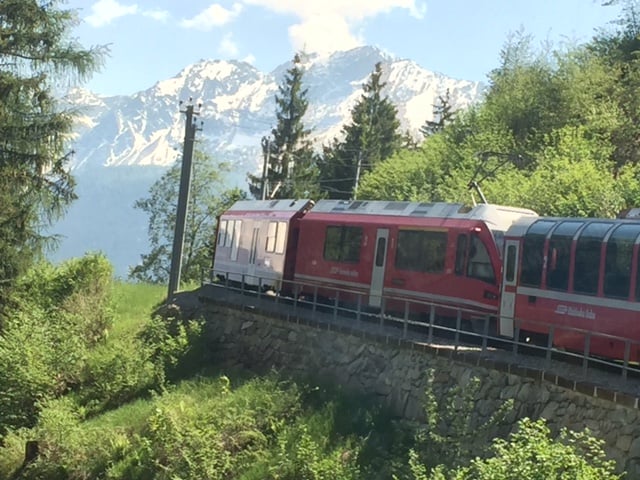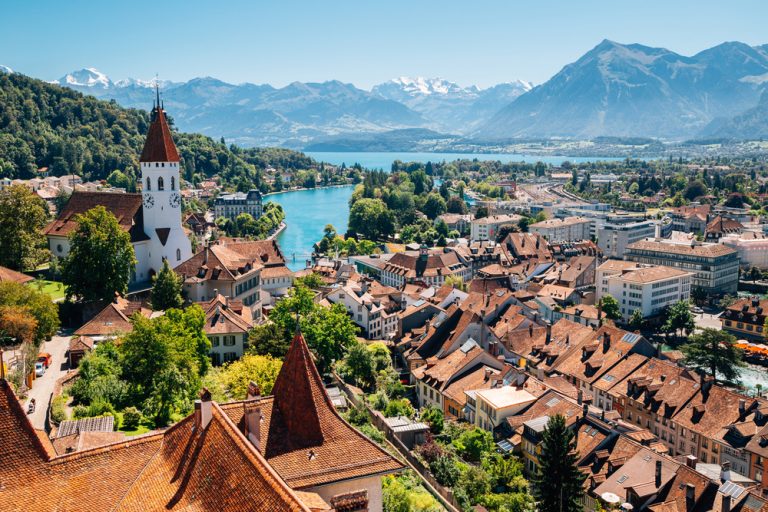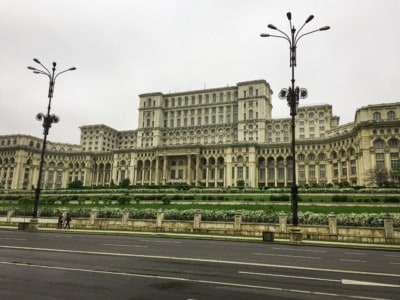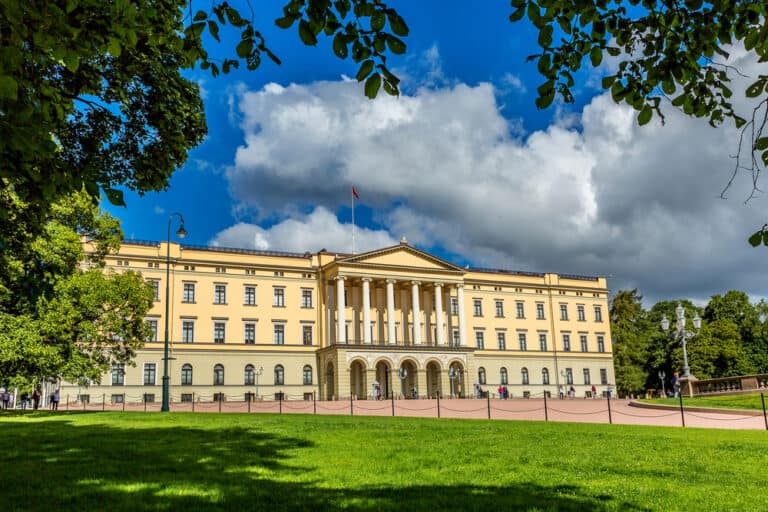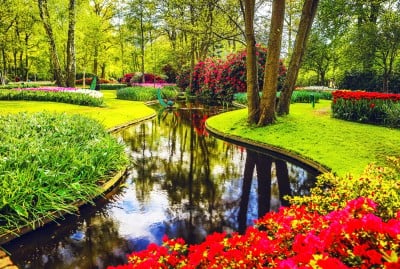Switzerland: The 17 best things to do in Neuchatel

Neuchatel is a beautiful city in western Switzerland, not far from Bern and Geneva.
It’s the perfect location for a short break or day trip. The city has a picturesque old town graced with a stunning lakeside setting, and there is plenty to do and see both here and nearby.
If you’re thinking of going, this post outlines the 17 best things to do in Neuchatel.
This post contains affiliate links
Where is Neuchatel?
The city of Neuchâtel is in western Switzerland. Being in French-speaking Switzerland, it is not far from Geneva (just over 100 km away). However, the capital, Bern is nearer (around 40 km away) in the German-speaking part.
The city stands on the shores of Lake Neuchâtel. This is the third largest lake in the Switzerland (the largest lake being Lake Geneva to the south) and the biggest one that is entirely located within the country’s borders.
The Jura Mountains are to the north.
How to get to Neuchatel
As Bern is the nearest large city to Neuchatel, it’s an easy place to combine with a trip to the capital. You could have a short break in each city or a day trip to Neuchatel (or vice versa).
The former is what I did when I visited: I spent 2 nights in Bern and 2 nights in Neuchatel. I caught the train between the two cities, which takes, on average, less than 50 minutes.
You can fly into Bern airport. However, as this airport is smaller than others in Switzerland, it’s often easier to get to Neuchatel via Geneva. The fastest trains from the airport take just over an hour and a half, even when a change of train is required.
Zurich airport is a little further away, but it is still feasible (around two and a quarter hours by train). The EuroAirport near to Basel is similarly over two hours away by train.
Getting around Neuchatel: The Neuchatel Tourist Card
Once you’re in Neuchâtel, pick up the Neuchâtel Tourist Card. You’re entitled to this if you stay at least one night in the canton. And given that it’s free and offers a variety of benefits, it’s a must!
The card – which you can get from your accommodation – gives you free travel on public transport, covering trains, buses and trams.
You can also travel on the local funiculars, including the one that takes you to Chaumont (one of the top things to do in Neuchatel) and on selected lake cruises.
You’ll also get free entry into 28 museums in the area, including several that are listed in this post.
Things to do in Neuchatel
Although Neuchâtel is a city, it’s a relatively small one, and when you’re there, it feels more like being in a town. This means it’s easy to get around and see the main sights.
Having said this, there’s plenty to do here to keep you busy on a short break.
Read on for some of the top things to do in Neuchatel and some of the best attractions to put on your itinerary.
Or alternatively, you could book this reasonably priced self-guided scavenger hunt city tour which guides you via Smartphone puzzles to find some of the main sights. It’s a great way to see the city and stretch your brain at the same time!
Explore the historic old town of Neuchâtel
The city’s old town dates back to the middle ages and is a real delight. It’s small and quaint, with narrow streets on which there are lots of historic buildings and statues, as well as the Castle of Neuchatel.
There are also several ornate and colourful fountains that you’ll see as you explore. A pretty clock tower overlooks one of these – the Banneret Fountain.
You should definitely take time to wander around the old quarter and take in your surroundings.
Of particular note is the old town square, the Place des Halles. This is a lively spot with several cafes and restaurants, all with outdoor seating.
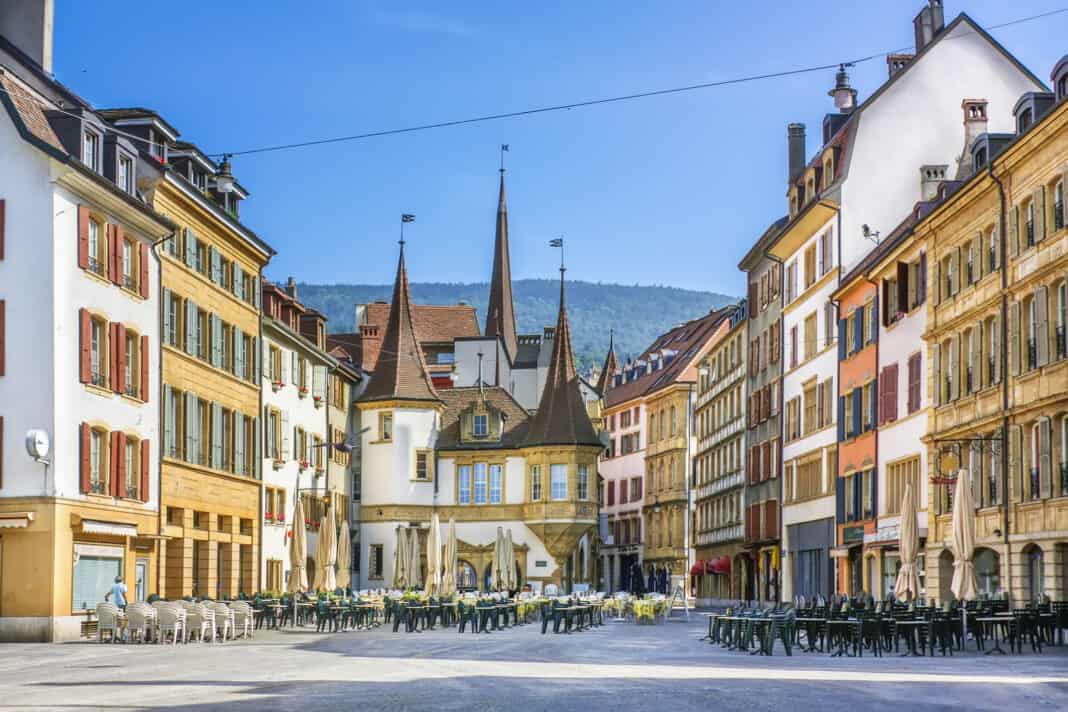
The square also has the distinctive Maison des Halles. This dominates the space with its arches at the bottom and eye-catching turrets. It is now a restaurant.

Visit Neuchatel Castle and the Collegiate Church
The word Neuchatel actually means ‘New Castle’. So a visit to see the Castle of Neuchatel is one to put on your list.
The castle dates back to the 10th century but has been altered several times. This has resulted in its current appearance that reflects different architectural styles and periods.
It is an impressive fortress with towers, turrets and white walls. There are two small courtyards inside.
The castle is also in the old town but set higher up on a hill.
From here you can get magnificent views of the old town and lake. In particular, there are views to be had from the Tower of Prisons (Tour des Prisons). This is one of the oldest structures in the city.

You can take guided tours around the castle on weekday afternoons (Tuesday to Sunday) during the summer months. Although it is worth remembering that the Tower of Prisons can only be visited during the 5 pm tour.
Next door to the castle is the Collegiate Church, a 12th century medieval building made with yellow limestone.

The interior of the church is worth popping in to see, with its cloister dating from the 19th century.
Wander alongside the lakeside
You can’t go to Neuchâtel without taking a wander along the lakeside.
There is a tree-lined promenade where you can have a pleasant walk while looking out on stunning vistas. Or you could take the weight off your feet on one of the benches along the way if you want to just relax and take in your surroundings.
As you wander along, you’ll come across a couple of striking statues of a man and woman that symbolise the Belle Epoque period in Neuchatel (if you want to learn more about the city during this time, you can take a tour).
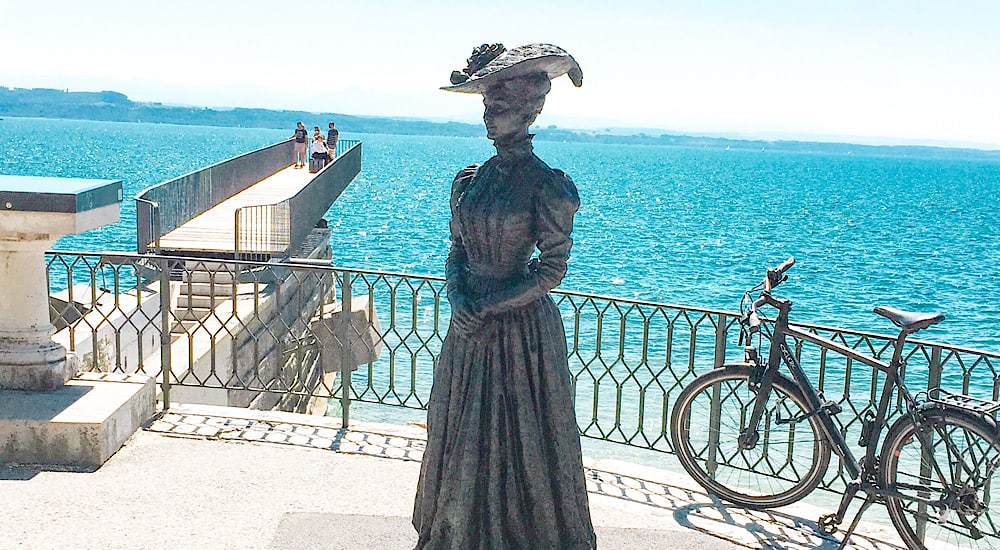
If you walk to the Port du Neuchatel, you can stop off for lunch in one of the restaurants around the marina. There are more at the Port de Saint Blaise further on.
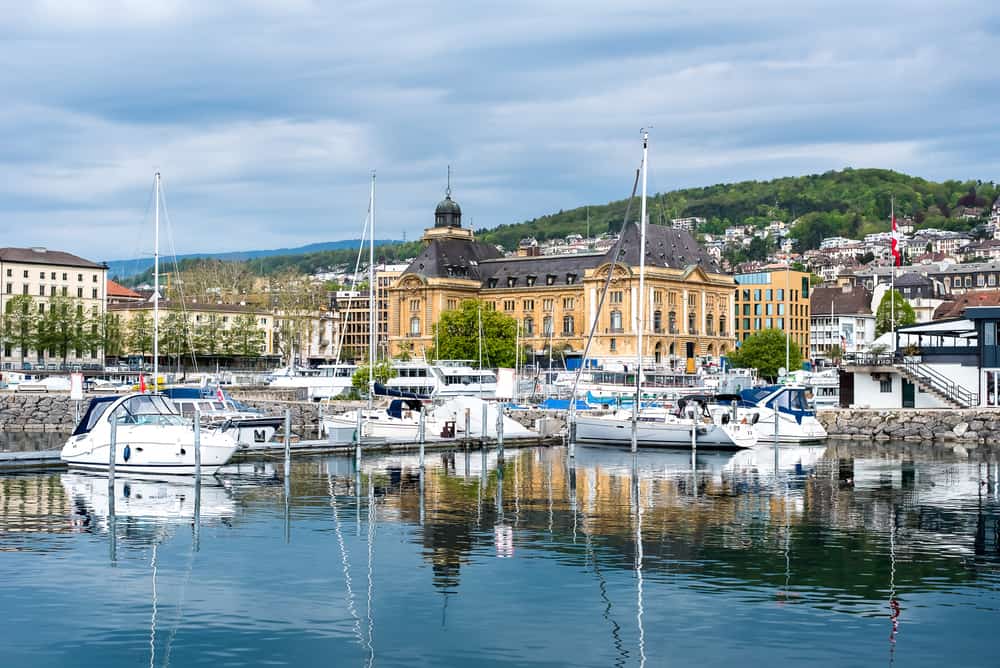
Ride La Coudre
La Coudre Funicular Railway (Funicular La Coudre-Chaumont) is a scenic funicular that connects Neuchatel with Chaumont Summit. As it travels its short 13-minute journey uphill to almost 1200 metres you get breathtaking views of the city, Lake Neuchâtel, and the Alps in the distance.
At the top, you can wander around and take in the region’s natural beauty. There are hiking trails, bike paths, picnic areas, and lookout points – one is an observation tower that you can climb for a small fee.
There’s also a small activity park for kids to run around in and a restaurant if you’re looking for great spot to dine in with spectacular views.
When you want to return from Chaumont, you can take the funicular back to town or walk via the ‘Path of Time’ (or Sentier du Temps) trail. This is a 4 km long walk downhill.
Note it is estimated that this can take an hour and a half, so if time is tight, this may not be possible. If you do have the time, you’ll walk past 17 sculptures that represent different aspects of evolution and time.
Take a boat trip on Lake Neuchatel
As the third largest lake in Switzerland, it’s not surprising that you can travel around the lake by boat. And you can do this for free with your Neuchatel Card.
The LNM company sails between various different places, giving you the chance to visit other towns on the lake.
There’s also ‘Three Lakes Region’ lake cruise that covers the three lakes of Neuchâtel, Biel, and Murten. These run from April to the end of October.
If you’re lucky, you might get to sail on the Belle Epoque steamer boat, which does this trip a few times a week.
Stroll through the botanical garden
If seeing the lakeside scenery or the mountains from Chaumont isn’t enough, you can also see some wonderful landscape with a visit to Neuchatel’s botanic garden (Jardin Botanique de Neuchatel). The garden is also set up high so presents another opportunity to look out across the area.
Entry is free, although you can pay for a guided tour if this interests you.
There are several different gardens here (including a Mediterranean garden, a vegetable garden, and ‘Garden of Evolution’) as well as meadows, orchards, vineyards, a stream, and ponds.
If you’re a hiker, you might also be interested in the fact that the ‘Path of Time’ trail from Chaumont runs very close by.
You can catch a bus from the city centre (the 106 or 109) to the garden.
See the Centre Durrenmatt and it’s ‘Sistine Chapel’ toilet
If you’re visiting the botanic garden (or even if you’re not), it is worth a trip to the Centre Dürrenmatt Neuchâtel (or CDN). The museum building is the space-age type structure with a lovely villa on top that’s nearby.
This was the former home of renowned Swiss artist and author Friedrich Dürrenmatt who died in the city in 1990. Architect Mario Botta added to the house to create the building that you see now.
Inside, the museum has a permanent exhibition dedicated to Durrenmatt’s life and works. You can also visit some of the rooms in which he lived and worked, including his study and library. Among these is a toilet – known as the ‘Sistine Chapel’ – that is covered floor to ceiling in brightly coloured murals!
As the CDN is near the botanic garden, you can also reach it via the 106 or 109 bus.
The museum is open from Wednesday to Sunday.
Go to the beach
Neuchâtel might be nowhere near the coast, but this doesn’t mean there are no beaches.
The Jeunes-Rives beach is just a short walk from the city centre. There’s a pebble beach here by the lake where you can sunbathe, picnic, cool off in the water, and just generally chill out – all with views across to the Bernese Alps.
Plus there are facilities such as toilets and showers, a restaurant, and beach volleyball if you want to make a day of it.
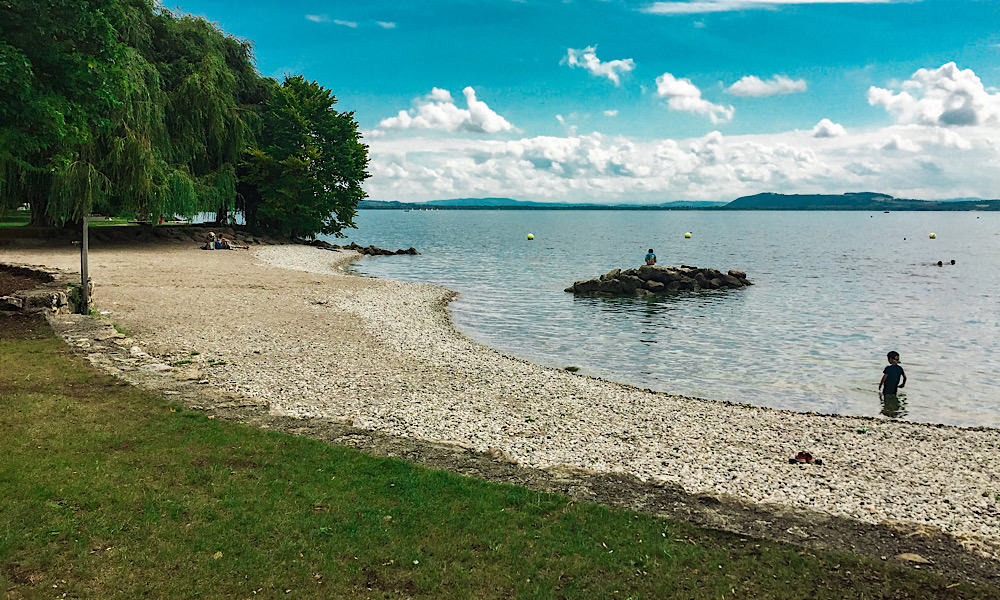
There’s also the Serrieres beach to the west of Neuchatel, the Plages Route des Falaises beach to the east, and others dotted around the lake.
You can check these out here.
Visit Switzerland’s largest archaeological museum
The Latenium is the country’s biggest museum dedicated to archaeology. It’s a few kilometres from Neuchatel’s main centre on the side of the lake and is open every day except Tuesdays.
Entry is free if you have a Neuchatel Tourist Card.
The museum’s separate collections span thousands of years. It houses over 500,000 (largely regional) artefacts, 3,000 of which can be viewed as part of its permanent exhibition.
If you’re interested in history and archaeology, this is one place to go.
Visit one of the other history museums in the city
In addition to the archaeological museum, there are numerous other museums to head to if this interests you or the weather is not kind when you visit. Many of these are free with the Neuchatel Tourist Card – although note that many do not open on a Monday, so check the websites in advance for their hours.
The Ethnography Museum (Musee D’Ethnographie Neuchatel) contains a large collection of objects from around the world. Around half are from Africa, with others from America, Europe, Asia, Oceania, and ancient Egypt.
You can catch the 101 bus from Place Pury to the museum, which is set up high with great views across the surrounding countryside.
The Natural History Museum (MHNN) is close to the old town. It has a range of collections contained within it, including – according to the website – “32,336 flies, 20,000 butterflies, 8,642 eggshells, 40 poles from the lake, 1 big penguin and 1 two-headed calf”! It also has a range of geological specimens.
See some art
There are also places in Neuchatel for art lovers. In addition to the Centre Durrenmat, there is the Art and History Museum (Musee d’Art et d’Histoire). This is not far from the lake in a historic Renaissance building.
It houses images, objects, and exhibitions in fine arts, applied arts, ceramics, sculpture and also has a range of historical items such as coins, jewellery, and tools.
If you’re interested in art, there is also CAN – the Centre d’art Neuchatel. This is a more recent addition to the city which opened in the mid-1990s. It showcases contemporary work from Swiss artists, as well as others from further afield.
The city also has several art galleries to browse.
Get some exercise
If you want to get out and partake in some exercise, then there are lots of opportunities to do this on a trip here and lots of leisure activities.
When I visited, I was struck by how many people were cycling and running around the lake. But if you live somewhere as beautiful as this, you can see why you’d choose these types of activities over going to a gym.
If you do want to go cycling, this website has a number of different routes of varying distances. A days’ free bike rental is included with your free Neuchatel Tourist Card if you’re staying for at least a night.
You can also wander through parks and gardens, go hiking in the local area, including in the Gorges de L’Areuse and the Creux du Van (see below for further information), or do some watersports.
The nearby town of Estavayer-le-Lac has a centre for water sports, complete with an 800 metre long lift for water skiing (this is apparently the longest in the country). If this is not for you, you can also hire pedaloes and paddle boards, or go canoeing.
You can drive or catch the train here, or – as it is on the other side of the lake – travel by boat.
You can also go ice skating in the Patinoires du Littoral rink by the lake and ski-ing nearby (e.g Les Bugnenets Savagnieres which is the biggest resort in the region).
The city also has several swimming pools you can take advantage of.
Learn about the Belle Epoque in Neuchâtel
The Belle Époque (“beautiful era” in French) was a period in the late 19th century/early 20th century that was characterised by optimism, prosperity, and cultural movements. Neuchatel also experienced this, and it’s possible to learn more about this on a visit to the city.
A “Neuchatel in the Belle Epoque” tour will take you around various sites in the city that are connected to this period.
This includes the lakeside statues of a man and woman in old costumes, 18 murals painted on walls (one is of Marthe Robert, the first woman to have swum across the lake), and the opportunity to clamber on-board a tram from the turn of the 20th century.
You can also book a lakeside cruise to ride on a Belle Epoque steamer boat.
Learn about the region’s history of clock-making
The Neuchatel region is well known for its role in watch and clock-making. Abraham-Louis Breguet, an inventor of watches, was born in the city in the mid-18th century, and there are several luxury watch brands based here and nearby.
If you want to learn more about the history of clock-making in the area, then there are two places to head to: La Chaux-de-Fonds and Le Locle.
La Chaux-de-Fonds
La Chaux-de-Fonds is less than half an hour by train from Neuchatel.
The International Clock-Making Museum (Musee International D’horlogerie) is here, where you can see thousands of different types of timepieces – from watches and clocks to sundials. You can also learn about the history of clock-making technology and of advances in the measurement of time.
As with the museums in Neuchâtel, this museum is not open on Mondays.
Le Locle
Le Locle is a bit further away from Neuchatel (about an hour). It is also known for its role in this industry, so much so that it’s been awarded UNESCO World Heritage status.
You can take the Watchmaking Path around the town and then visit the Le Locle Watchmakers Museum (Musee d’horlogerie du Locle). This fascinating museum – which displays a collection covering more than a 500-year period – is located in the Chateau des Monts, an old manor house about a kilometre away from the centre of Le Locle.
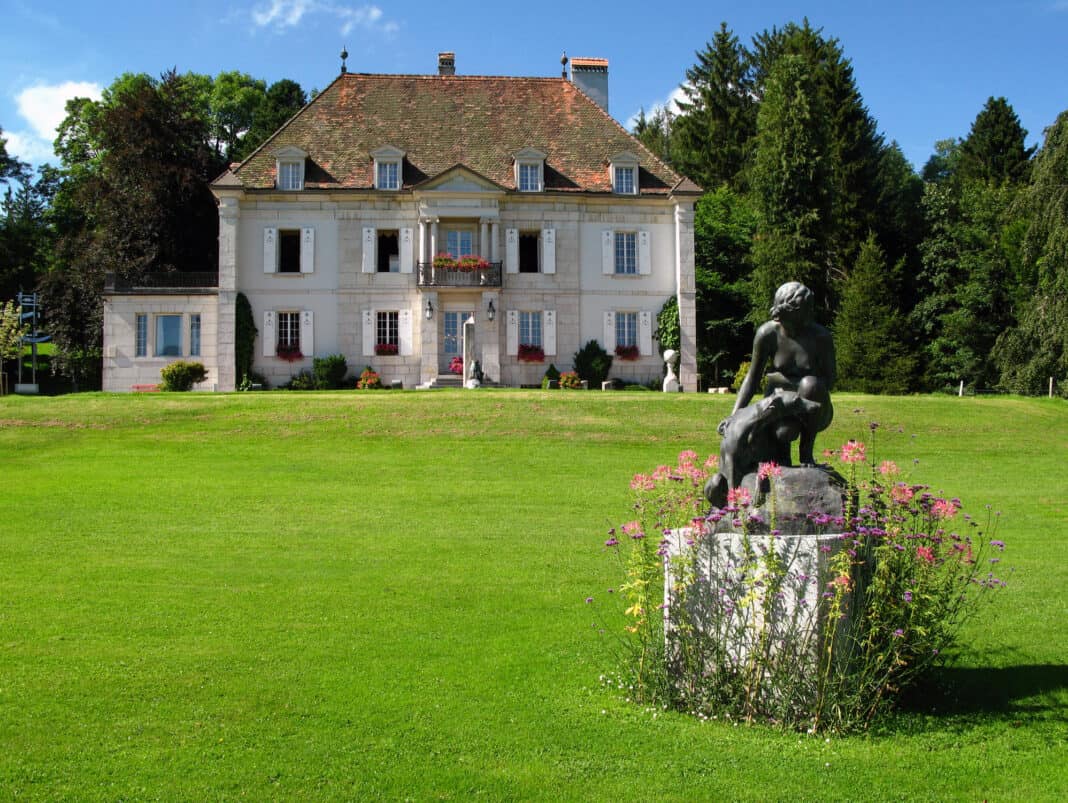
Experience some of the area’s natural features
With its lakes and mountains, this part of Switzerland is full of wonderful landscapes and beautiful scenery to explore. As mentioned above, you can cycle and hike around the area and ski down mountains in winter.
You can also visit the following nearby places in the warmer months.
The Gorges de l’Areuse
The Gorges de L’Areuse is a natural geological formation in the area which is a popular destination for hikers and nature enthusiasts.
A beautiful hike starts in Noiraigue (about 20 minutes by train from Neuchatel). It runs along the railway line, passing by the Saut de Brot stone bridge and through tunnels. It ends at Boudry train station, 11.5 km away.
You can then return to Noraigue by train or hop on the Littorail narrow-gauge railway back to Neuchâtel. And if you don’t want to walk the whole route, you can break it at Champ-du-Moulin (there is also a restaurant here if you need a break).
The Creux du Van
This is another spectacular geological formation in the area. It has horseshoe-shaped craggy rock faces which overlook the valley below from 160 metres high.
From this vantage point, you get views across lakes, valleys, the Alps, and over to France.

If you fancy a hike, there is the 14 km Sentier des quatorze contours(‘Trail of the 14 Bends’), so named because of the 14 180-degree curves on its route.
The Creux du Van can be reached by walking from Noiraigue, so you could visit this after walking along the Gorges de L’Areuse (and if you have some energy left!).
Le Saut du Doubs
This natural waterfall is nearby on the border between Switzerland and France.
You can hike along the river to see the waterfall. Or, for something more restful, you can go to the town of Les Brenets (your Neuchatel Tourist card includes a return boat trip here) and catch another boat to see it plunging 27 metres into the Doubs river.
And if you fancy some food (as well as something slightly potent!), stop at the L’Absinthe restaurant by the waterfall. You can sit in a shady garden and try its “award-winning” absinthe.
Day trip to Bern
The capital of Switzerland, Bern, is less than an hour away by train. This makes it a great place for a day trip from Neuchatel. And the fact that it is closer in size to a large town means that it’s easy to see the main sights during a day trip.
Things to do with one day in Bern
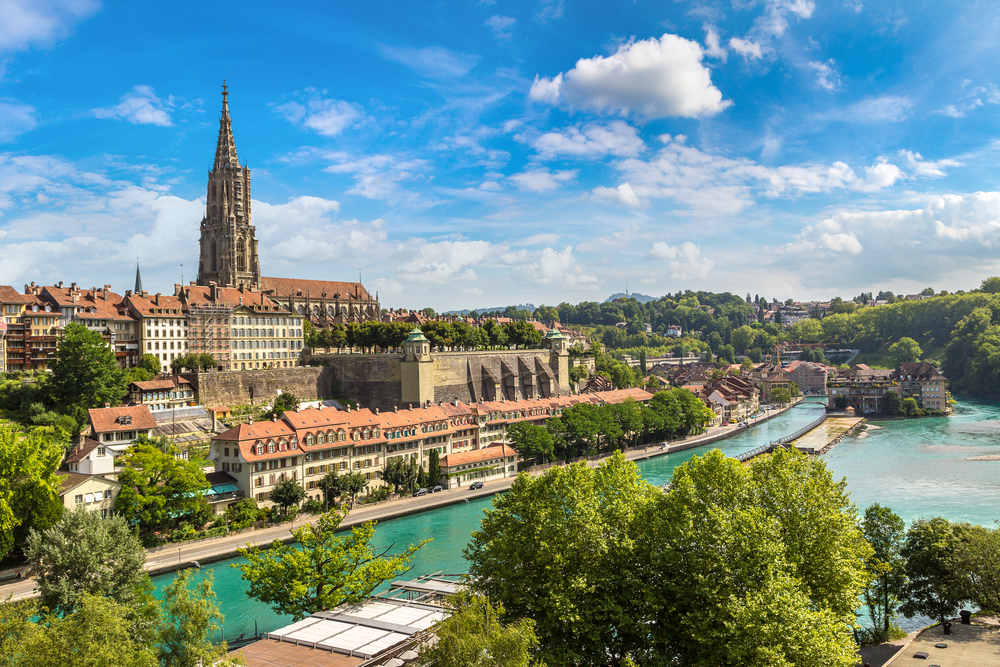
With one day in Bern, you can wander around the quaint UNESCO World Heritage old town, with its magnificent 13th-century medieval clock tower. This is one of the city’s most photographed buildings, and you’ll see people congregating in front of it to see the mechanical figures emerge and put on a show when it strikes the hour.
If you’re feeling energetic, climb to the top to get some views over the city.
There are also some grand buildings to see, including the Federal Palace and Bern Minster, and several museums. A couple of these provide information on one of the city’s most famous residents, Albert Einstein.
And for a bit of fresh air, you can stroll through the pretty Rosengarten (another place where you can marvel at amazing views), and see the city’s bears which roam along the river bank.
If you fancy a day out here, see my post which outlines the top things to do with one day in Bern.
Visit Geneva
Another place to consider for a day trip is Geneva – or you may want to stop off here en-route to Neuchatel if you have flown into the city.
Geneva is another Swiss city that sits on a lake – in fact, the largest lake in Switzerland, Lake Geneva. It’s known for its beautiful architecture and its world-renowned museums.
Although there are lots of things to see here, one day in Geneva is the perfect amount of time to explore the city. It’s enough time to see the main sights and to earmark Geneva for a future visit if you like what you see.
Things to do with one day in Geneva
As with both Neuchâtel and Bern, there is a charming old town to explore with quaint streets, small squares, and historic medieval buildings. One of these is the 12th-century St. Pierre Cathedral where you can climb to the top of one of the towers.
You can also stroll around the lake (look out at the Jet d’Eau that spurts 140 metres into the air), through the Jardin Anglais with its unique Floral Clock (L’horloge Fleurie), and into Bastions Park.
The latter has the 100-metre long Reformation Wall that commemorates the leading figures of the Protestant Reformation.

There’s also an excellent selection of fascinating museums and buildings to visit. These include The Palais des Nations (the United Nations’ headquarters), the International Red Cross and Red Crescent Museum, and Musee d’art et d’histoire.
Or you could just book a boat trip, sit back, relax, and look out on the city from the water!
See my separate post for an itinerary for one day in Geneva.
What to do in Neuchatel
If you do visit Neuchatel, I hope you enjoy your time in this charming city as much as I did. It’s the perfect place for a short break or day trip. Enjoy!
For other ideas for short breaks in Switzerland, see my posts on Geneva, Zurich, Rapperswill, Lugano, and Lucerne. You can also day trip from Zurich to Vaduz in Leichtenstein.



